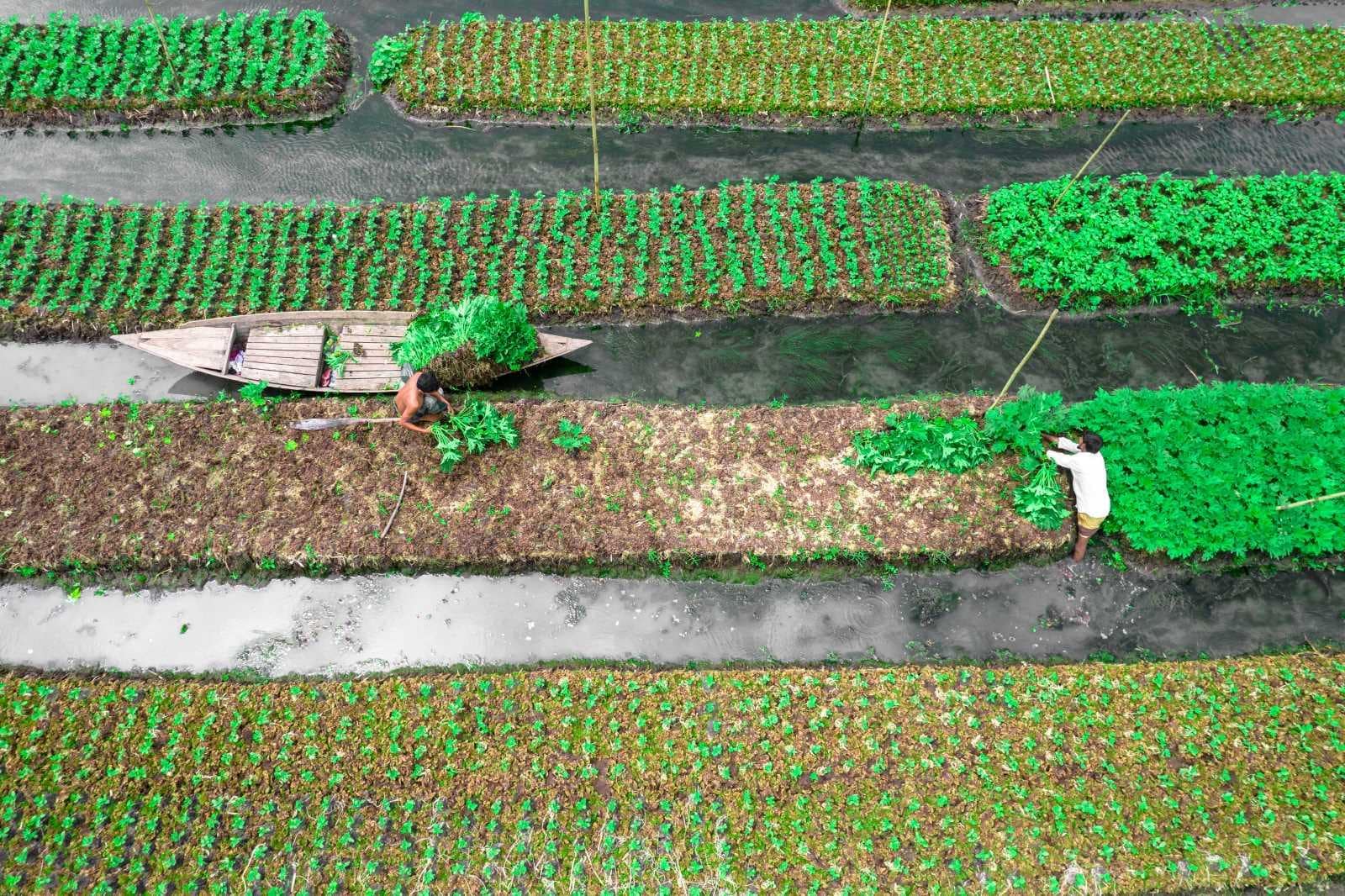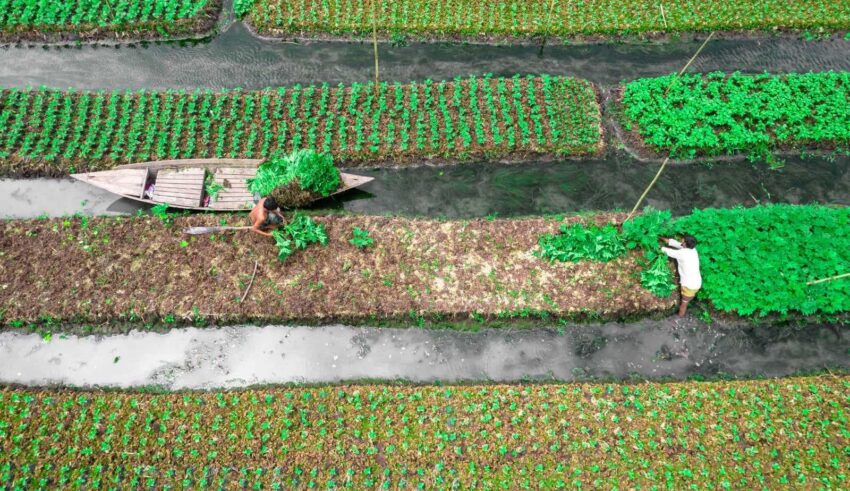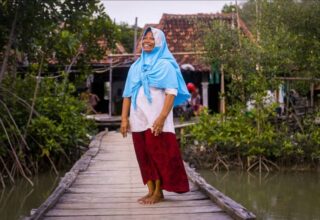
picture-alliance/ZUMAPRESS.com/Mustasinur Rahman Alvi
When Bangladesh became independent in 1971, it was an agrarian country with low incomes on average. Today, agriculture is no longer dominant, contributing only about 14 % to gross domestic product. Nonetheless, the sector still matters very much. It employs a bit less than half of the workforce and accounts for almost 60 % of female employment.
Rural livelihoods in the country’s Delta landscape tend to depend on farms, most of which are quite small. More than 80 % of the farmer population owns less than one hectare of land. Many people must therefore work as daily labourers or lease land from prosperous landlords. Either way, they typically work in conditions of exploitation.
Average incomes have increased in Bangladesh, so it became a lower-middle income country in 2015. While agriculture has helped to reduce poverty, families that depend on small-scale farming still struggle to make ends meet. The climate crisis is exacerbating their economic misery.
The long-term outlook is worrisome too. Environmental change is set to reduce rice production by one-third in 20 years, according to one forecast.
The typical impacts of global heating differ from region to region. The Northwest is Bangladesh’s agricultural hub. It has been experiencing scant rainfall, increasing aridity and drought-like conditions. Unusual heat is becoming increasingly normal, moreover. By contrast, the Northeast has been seeing flash floods and excessive rains, while the coastal South is affected by tropical cyclones, tidal surges, sea level rise and salinity intrusion.
All of these phenomena disrupt farming. Both sudden and full-onset events matter. Floods, storms, and draughts destroy harvests, causing immediate damage. Longer-term trends like salinisation or dropping ground-water levels, however, eventually make farms unviable.
Multidimensional deprivation
The poorest farmers are the least able to adapt, not least because they face several socio-economic challenges. These families only have limited access to formal education. As a result, their access to support services (including skills training), financial services and technology is limited too. People with little formal education, moreover, often become victims of marginalisation, systemic injustice and exploitation.
Experience shows that small-scale farmers struggle to get cheap loans even from the state-owned Bangladesh Krishi Bank, which has the mission to support agriculture. The same farmers also hardly benefit from the government’s agricultural extension services. To a large extent, they are left to themselves.
Their multidimensional deprivation has serious implications. When small-scale farmers finance investments with loans, they pay comparatively high interest rates and thus run disproportionately great risks. Their leap of hope can end in devastating failure if an extreme weather event wipes out their harvest. Once they become unable to repay a loan, they drop into even worse poverty.
Small-scale farmers are clever and enterprising people. Their creativity enables them to cope with very difficult socio-economic circumstances. As they normally lack funding and expertise, they tend to shy away from costly innovative approaches. Unfortunately, sticking to inherited traditions is not a good choice when the environment is changing. While poor rural communities are particularly exposed to the impacts of climate change, they find it particularly difficult to adapt to it.
How to adapt
There are, of course, options for adapting. In the increasingly arid Northwest, it makes sense to store water in reservoirs. Villagers thus benefit from digging ponds. Switching to crops that need less water is useful too. Instead of growing rice in two seasons, for example, a family farm may switch to potatoes in the second. Eco-farming practices like zero tillage and mulching have proven their worth. That is equally true of priming, a technology that supports seed germination with appropriate moisture and temperatures.
Adaption strategies are different in flood-prone areas. Relevant options include cage culture for breeding fish, floating gardens for growing vegetables on rafts and subsistence crop cultivation at the household level. Well-advised farmers, moreover, opt for flood-tolerant and short-yielding crop varieties.
Along the ocean coast, saline-tolerant and deep-rooted crop varieties are useful. In view of the salination of existing water resources, harvesting rainwater is relevant too.
Unfortunately, some adaptation attempts have turned out to be unsustainable or to have undesired side effects. The salinisation of coastal rivers has let shrimp farming proliferate, often with good financial returns. The downside is that shrimp farming changes the local environment to the detriment of rice farming. In the coastal district of Satkhira, rice production declined by two-thirds from 1985 to 2005. Small-scale farming families were displaced accordingly.
A similar trend is reported from the Northwest, where mango orchards became a response to more arid conditions. Mangoes are a valuable cash crop, but the orchards require less labour than rice cultivation. Unemployment increased, therefore. Here too, migration from rural areas to cities has become a common consequence.
Making the right choices obviously requires reliable information. Prosperous farmers with large land holdings typically get the professional advice and the financial services they need.
Four issues matter in particular
The big challenge is to empower poor farmers to choose competently. Government institutions, civil-society organisations and international development agencies have been making efforts to achieve that, but more remains to be done. Four issues deserve particular attention:
- First of all, it is important to develop leadership skills among the members – and especially women – of disadvantaged communities. Their involvement in decision-making is important, but they will not be heard unless they learn to make themselves heard. Multidisciplinary stakeholders should pay close attention to what local people need. Rural women matter in particular.
- Formal education – including vocational training, skills development, and technological expertise – matters very much. “Farming schools” can make a difference and so can public-private partnerships.
- Access to the financial sector must improve. Rules and regulations should be made more flexible in favour of small-scale farmers. Apart from loans, insurance schemes should be considered, since they are valid risk-management tools.
- Rural communities can benefit from more localised and accurate weather reports. Early warning systems should improve as well.
To achieve progress regarding all points in the list above, cooperation and coordination among stakeholders must improve. Relevant parties are grassroots communities, government agencies at national and subnational levels, civil-society organisations and international development partners.
Download This Publication HereOriginally this Article was published on November 5, 2023 at D+C website.
Savio Rousseau Rozario is Program Coordinator for the Locally Led Adaptation (LLA) Program at the International Centre for Climate Change and Development (ICCCAD).









